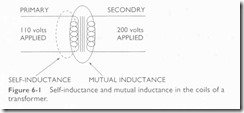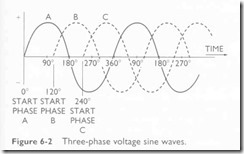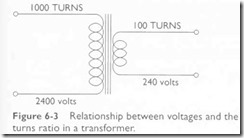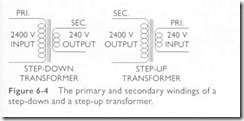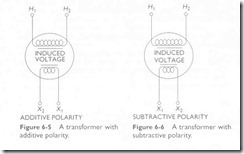|
6-1 What is induction? The process by which one conductor produces, or induces, a voltage in another conductor, even though there is no mechanical coupling between the two conductors. |
|
6-2 What factors affect the amount of induced electromotive force ( emf) in a transformer? The strength of the magnetic field, the speed at which the conductors are cut by the magnetic field, and the number of turns of wire being cut by the magnetic field. |
|
6-3 What is inductance? The property of a coil in a circuit to oppose any change of existing current flow, |
|
6-4 What is self-inductance? The inducing of an emf within the circuit itself, caused by any change of current within that circuit. This induced emf is always in a direction opposite to the applied emf, thus causing opposition to any change in current within the circuit itself. |
|
6-5 What is mutual inductance? The linkage of flux between two coils or conductors, caused by the current flowing within one or both of the coils or conductors. |
|
6-6 Draw a diagram of two coils, such as the coils of a transformer winding, and indicate the self-inductance and the mutual inductance. Self-inductance is produced within the primary coil, and mutual inductance exists between the two transformer coils, as shown in Figure 6-1. |
|
6- 7 Name several methods by which an emf can be generated. By conductors being cut by a magnetic field (as in generators), by chemical reactions (as in batteries), by heat (as in thermocouples), by crystal vibration (as in piezoelectricity), and by friction (as in static electricity). |
|
6-8 What is direct current (de)? Current that flows in one direction only. |
|
6-9 What is alternating current (ac)? Current that continually reverses its direction of flow, |
|
6-10 What is pulsating direct current? An unidirectional current that changes its value at regular or irregular intervals. |
|
6-11 What is a cycle? One complete alternation, or reversal, of alternating current. The wave rises from zero to maximum in one direction, falls back to zero, then rises to maximum in the opposite direction, and finally falls back to zero again. |
|
6-12 what always surrounds a conductor when a current flows through it? A magnetic field. |
|
6-13 What is the phase relation between the three phases of a three-phase circuit? They are 120 electrical degrees apart. |
|
6-14 Draw sine waves for three-phase voltage; show polarity, time, and phase angle (in degrees). Sec Figure 6-2. |
|
6-15 What is the phase relation between phases in two-phase circuit? They are 90 electrical degrees apart. |
|
6-16 What is a transformer? A device that transforms electrical energy from one or more circuits to one or more other circuits at the sarne frequency but usually at a different voltage and current. It consists of a core of soft-iron laminations surrounded by coils of copper-insulated wire. |
|
6-17 There are two basic types of transformers. what are they? The isolation type, in which the two windings are physically isolated and electrically insulated from each other, and the autotransformer type, in which there is only one coil with a tap or taps taken off it to secure other voltages (the primary is part of the secondary and the secondary is part of the primary}. |
|
6-18 What is an oil-immersed transformer? The core and coils are immersed in a high-grade mineral oil, which has high dielectric qualities. |
|
6-19 Why is oil used in a transformer? To increase the dielectric strength of the insulation, to keep down the possibility of arcing between coils, and to dissipate heat to the outer case so that the transformer can carry heavier loads without excessive overheating. |
|
6-20 What is an air-core transformer? A transformer that does not contain oil or other dielectric compositions but is insulated entirely by the winding insulations and air. |
|
6-21 What are eddy currents? Circulating currents induced in conductive materials (usually the iron cores of transformers or coils) by varying magnetic fields. |
|
6-22 Are eddy currents objectionable? Yes, they represent a loss in energy and also cause overheating. |
|
6-23 what means can be taken to keep eddy currents at a minimum? The iron used in the core of an alternation-current transformer is lamina ted, or made up of thin sheets or strips of iron, so that eddy currents will circulate only in limited areas. |
|
6-24 What is hysteresis? When iron is subjected to a varying magnetic field, the magnerism lags the magnetizing force due to the fact that iron has reluctance, or resistance, to changes in magnetic densities. |
|
6-25 Is hysteresis objectionable? Yes, it is a loss and affects the efficiency of transformers. |
|
6-26 Are transformers normally considered to be efficient devices? Yes, they have one of the highest efficiencies of any electrical device. |
|
6-2 7 What factors constitute the major losses produced in transformers? Power loss of the copper (12 R losses), eddy currents, and hysteresis losses. |
|
6-28 Is there a definite relationship between the number of turns and voltages in transformers? Yes, the voltage varies in exact proportion to the number of turns connected in series in each winding. |
|
6-29 Give an illustration of the relationship between the voltages and the turns ratio in a transformer. If the high-voltage winding of a transformer has I 000 turns and a potential of 2400 volts is applied across it, the low-voltage winding of l 00 turns will have 240 volts induced across it; this is illustrated in figure 6-3. |
|
6-30 What is the difference between the primary and the secondary of a transformer? The primary of the transformer is the input side of the transformer and the secondary is the output side of the transformer. On a step-down transformer; the high-voltage side is the primary and the low-voltage side is the secondary; on a step-up transformer, the opposite is true (Figure 6-4 ). |
|
6-31 Ordinarily, what is the phase relationship between the primary and secondary voltages of a transformer? They are 1 80° out of phase. 6-32 Is it possible to have the primary and secondary of a transformer in phase? Yes, by changing the connections on one side of the transformer; |
|
6-33 How are the leads of a transformer marked, according to ANSI (American National Standards Institute)? |
The high side of the transformer is marked H 1, H2, etc. The low side of the transformer is marked X 1, X 2, etc.
|
6-34 What is the purpose of the markings on transformer leads? They arc there for standardization, so that transformer polarities are recognizable for any type of use. 6-35 Draw a diagram of a transformer with additive polarity, using ANSI markings. |
See Figure 6-5.
